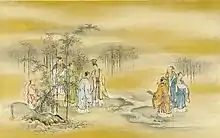
Seven Sages of the Bamboo Grove
Kanō Tanshin (Morimasa) (狩野 探信, 1653–1718) was a Japanese painter. He was the son of Kanō Tan'yū by his second wife and led the Kajibashi branch of the Kanō school after 1674. Stylistically, he was known for his Tosa-like approach (competing with the Tosa school), but more notably, for his slight departure from the imitative style of Kanō school masters. This departure became a significant point of criticism in the rebellious anti-Kanō school movement of the late Edo period.[1] Parallel anti-Kanō school artist Hanabusa Itchō commended Tanshin for his "rare talent," derived from his ability to use nature as a model.[2] Itchō asserted that Tanshin became a true artist by capturing the spirit of the bamboo to convey an idea.[2]
References
- ↑ Jordan, Brenda G.; Weston, Victoria Louise (2003). Copying the Master and Stealing His Secrets: Talent and Training in Japanese Painting. University of Hawaii Press. ISBN 9780824826086.
- 1 2 Wattles, Miriam (2013-10-18). The Life and Afterlives of Hanabusa Itchō, Artist-Rebel of Edo. BRILL. ISBN 9789004259171.
This article is issued from Wikipedia. The text is licensed under Creative Commons - Attribution - Sharealike. Additional terms may apply for the media files.